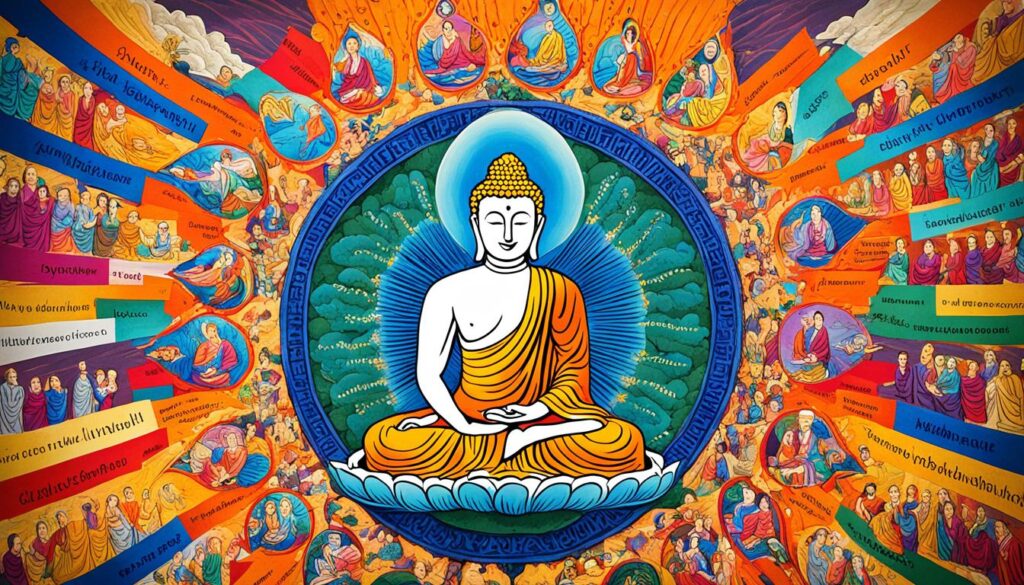Have you ever wondered about the fascinating journey of Buddhism throughout history? How did this ancient religion originate and evolve over time? Delve into the rich chronology of Buddhism as we unravel its compelling timeline, from its humble beginnings to its widespread influence.
Key Takeaways:
- Buddhism traces its roots back to the 5th century BCE when Siddhārtha Gautama, the Buddha, founded the religion in ancient India.
- The Buddhist sangha, or monastic community, spread throughout the Indian subcontinent after the Buddha’s passing.
- Emperor Ashoka of the Maurya Empire played a pivotal role in establishing Buddhism as a major religion and promoting its teachings.
- The first schism within the sangha led to the development of different Buddhist schools and sects.
- Ashoka’s missions helped spread Buddhism to various parts of India and beyond, leading to its expansion.
Early Buddhism and the First Schism
After the Buddha’s death, divisions within the sangha led to the first schism in the history of Buddhism. The Sthavira (Elders) and Mahasamghika (Great Sangha) groups disagreed on various doctrinal matters, primarily concerning monastic discipline or vinaya.
This disagreement resulted in the development of different Early Buddhist Schools, each with its own unique teachings and interpretations. These schools played a crucial role in shaping the future of Buddhism and its spread across different regions.
The emergence of Early Buddhist Schools marked an important chapter in the evolution of Buddhism, as it allowed for the exploration of diverse philosophical perspectives and approaches to practice. Among the notable schools that emerged during this period were Sarvāstivāda, Pudgalavāda, Dharmaguptaka, Vibhajyavāda, and Mahāsāṃghika.
The Sarvāstivāda School
The Sarvāstivāda School, also known as the “Doctrine of the All Exists,” believed in the existence of all dharmas (phenomena) in the past, present, and future. They emphasized the teachings of the Abhidharma, a systematic and analytical exposition of Buddhist doctrine.
The Mahāsāṃghika School
The Mahāsāṃghika School, meaning “Great Sangha,” focused on preserving the unity and simplicity of the Buddhist community. They argued for a more flexible interpretation of monastic rules and believed that enlightenment was attainable by all individuals, regardless of their level of spiritual development.
Dharmaguptaka, Vibhajyavāda, and Pudgalavāda Schools
The Dharmaguptaka School placed special emphasis on the vinaya, the monastic discipline, and led the spread of Buddhism to regions such as Central Asia, China, and Korea. The Vibhajyavāda School emphasized analytical and critical examination of the Buddhist scriptures, while the Pudgalavāda School focused on the existence of a personal self or pudgala, which was controversial among other Buddhist schools.

These Early Buddhist Schools played a significant role in shaping the diverse landscape of Buddhism and its subsequent development. While they may have had their differences, they all shared a common goal of propagating the teachings of the Buddha and helping individuals attain liberation from suffering.
Ashokan Missions and the Spread of Buddhism
During the reign of Emperor Ashoka, Buddhism gained royal support and began to spread widely. Ashoka’s remorse after his invasion of Kalinga led him to embrace Buddhism and work towards improving the lives of his subjects. He built wells, rest houses, and promoted human rights. Ashoka also sent missions to various parts of India and beyond, spreading the teachings of Buddhism. This period marked a significant expansion of Buddhism and the establishment of Buddhist institutions across the Indian subcontinent.

Missions of Emperor Ashoka
Emperor Ashoka, also known as Ashoka the Great, implemented a series of missions to promote the spread of Buddhism. These missions were significant in consolidating and expanding the influence of Buddhism throughout ancient India and beyond. Ashoka’s missions encompassed various regions, including present-day Afghanistan, Nepal, Pakistan, and Sri Lanka.
Ashoka’s missions were not only aimed at propagating Buddhist teachings but also focused on establishing pillars of moral and ethical conduct. The missions were accompanied by edicts engraved on pillars and rocks, disseminating Ashoka’s messages of peace, tolerance, and social welfare.
The Impact of Ashokan Missions
The Ashokan missions played a crucial role in the spread of Buddhism across different parts of the world. They helped establish Buddhist communities, monasteries, and centers of learning, contributing to the growth and development of Buddhism as a major religion.
Ashoka’s missions not only brought Buddhism to new regions but also facilitated cultural exchange and the spread of knowledge. Buddhist monks and scholars traveled with the missions, disseminating Buddhist texts, teachings, and practices. They also engaged in intellectual debates and discussions, contributing to the development and diversification of Buddhist philosophy.
The Legacy of Ashoka and Buddhism
Ashoka’s reign and his efforts to promote Buddhism left a lasting impact on the history and development of Buddhism. The Ashokan missions laid the foundation for the expansion of Buddhism, establishing a network of Buddhist centers that would continue to flourish for centuries to come.
Furthermore, Ashoka’s emphasis on humanitarian principles and social welfare set a precedent for the integration of Buddhism with governance. His commitment to public welfare and the principles of dharma influenced subsequent rulers and societies, leaving a profound legacy on the ethical and moral aspects of Buddhism.
| Impact of Ashokan Missions | Description |
|---|---|
| Spread of Buddhism | The missions helped Buddhism reach new regions and establish thriving Buddhist communities. |
| Cultural Exchange | The missions facilitated the exchange of ideas, knowledge, and cultural practices between different regions. |
| Development of Buddhist Philosophy | Monks and scholars accompanying the missions contributed to the diversification and development of Buddhist philosophy through intellectual discussions and debates. |
| Integration of Buddhism with Governance | Ashoka’s focus on humanitarian principles influenced subsequent rulers in integrating Buddhism with governance and promoting social welfare. |
Further Developments and Sectarian Divisions
In the third century BCE, new systematic teachings known as Abhidharma emerged, representing a significant milestone in the development of Buddhism. Building upon earlier lists of doctrinal topics, the Abhidharma aimed to provide a comprehensive analysis and explanation of Buddhist teachings. It delved into intricate details regarding the nature of reality, consciousness, and the workings of the mind, offering practitioners a deeper understanding of the Buddhist path.
This period also witnessed the proliferation of various sects and schools within Buddhism, leading to sectarian divisions within the community. As the Abhidharma gained prominence, it further contributed to the diversification and specialization of Buddhist thought. Each school developed its own interpretation of the Abhidharma, creating distinct philosophical frameworks and practices.
These sectarian divisions sometimes led to intense debates and disagreements among Buddhist scholars and practitioners. However, the diversity of views also fostered an environment of intellectual exploration and innovation within the Buddhist community. Different schools focused on various aspects of the teachings, thereby expanding the breadth and depth of Buddhist thought.
FAQ
What is the timeline of Buddhism’s journey?
The history of Buddhism can be traced back to the 5th century BCE when Siddhārtha Gautama, also known as the Buddha, founded the religion in the small Shakya Republic in ancient India. After the Buddha’s death, the Buddhist sangha, or monastic community, spread throughout the Indian subcontinent.
What was the first schism in Buddhism?
After the Buddha’s death, divisions within the sangha led to the first schism between the Sthavira (Elders) and Mahasamghika (Great Sangha) groups. This resulted in the development of different Early Buddhist Schools, such as Sarvāstivāda, Pudgalavāda, Dharmaguptaka, Vibhajyavāda, and Mahāsāṃghika.
How did Emperor Ashoka contribute to the spread of Buddhism?
During the reign of Emperor Ashoka, Buddhism gained royal support and began to spread widely. Ashoka’s remorse after his invasion of Kalinga led him to embrace Buddhism and work towards improving the lives of his subjects. He built wells, rest houses, and promoted human rights. Ashoka also sent missions to various parts of India and beyond, spreading the teachings of Buddhism.
What were the further developments and sectarian divisions in Buddhism?
In the third century BCE, new systematic teachings called Abhidharma emerged, based on previous lists of doctrinal topics. This period marked a significant expansion of Buddhism and the establishment of Buddhist institutions across the Indian subcontinent. However, the schism between different Buddhist schools and sects continued, leading to further divisions and the development of distinct traditions within Buddhism.

